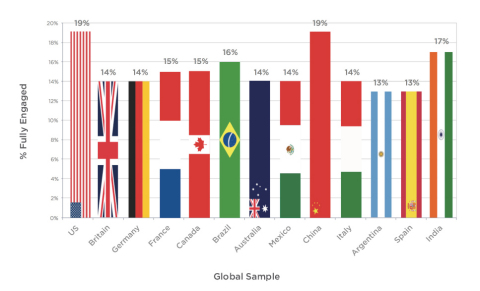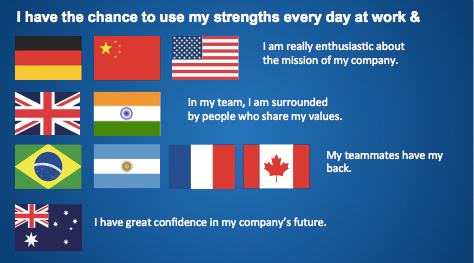LOS ANGELES--(BUSINESS WIRE)--While employee engagement has been consistently linked to positive business outcomes — including revenue, customer satisfaction and performance — never before has there been a methodological, calibrated global study of engagement across countries. Meanwhile, in the increasingly globalized nature of the Fortune 500, companies continue to struggle with fundamental people processes, much less implementing effective engagement measures that resonate in multinational teams. In fact, 64 percent of respondents in Sierra-Cedar's 2014-2015 HR Systems survey cites basic “business process improvement” as their top initiative.
The Marcus Buckingham Company (TMBC), providers of integrated, personalized and strengths-based employee engagement and performance solutions, today announces the results of the StandOut Global Engagement Index (GEI), the first-ever standardized worldwide employee engagement study. To equip team leaders with actionable, accurate data needed to effectively manage global workforces, the Index uncovers the percentage of fully engaged employees across more than a dozen participating countries as well as the leading country-specific drivers of engagement today.
“Consistent, reliable data is at the core of every great people decision we make. TMBC is committed to filling a substantial gap in such data with the release of the StandOut Global Engagement Index, sharing both country benchmarks and actionable, country-specific engagement drivers for teams globally,” said Marcus Buckingham, Founder, TMBC. “The StandOut GEI results will be immediately embedded within our education, consulting and technology solutions for TMBC customers.”
Ranking of Countries with Most Engaged Workforces
Based on responses of employees across the 13 countries included in the Index, the U.S. and China reported the highest percentage of “fully engaged” employees (19% each), while Argentina and Spain show the lowest occurrence of such employees (13% each). “Fully engaged” employees constitute those who strongly agree with the eight engagement-related statements posed in the Index. Full country by country rankings are available at http://www.tmbc.com/gei.
“These findings point to two key themes in the state of engagement today. The first is that despite China and the U.S. leading the pack in terms of the most fully engaged workforces, even in those countries less than a quarter of employees are wholly committed,” said Jason Averbook, CEO, TMBC. “The second is the urgent need for country-specific resources — not a one-size-fits-all approach — to drive up the percent of fully engaged workforces, team by team and country by country.”
Leading Drivers of Engagement Vary across Countries
TMBC’s StandOut Global Engagement Index leverages eight predictor statements from TMBC’s Engagement Pulse. The eight statement survey, which TMBC is making available for all teams globally to take at no cost, are the result of decades of research with a focus on reducing both measurement and psychometric error, and are measured on a Likert scale (1-5). The StandOut Global Engagement Index is the only worldwide engagement survey to be calibrated according to both cultural survey-taking nuances (i.e. Mexican respondents tend to lean toward extremes of survey scales) as well as the variable weight of each of these eight statements across countries.
The Index reveals that in each country, despite significant cultural differences, the single biggest driver of fully-engaged employees is the statement: “I have the chance to use my strengths every day at work.” This finding holds even after applying the country-specific calibration, and is consistent with academic research over the past decade.
“Although corporate methods, behaviors and values vary by country—and by industry—the most powerful human need at work remains the same: ‘help me discover my strengths, and help me use them a lot,’” continued Buckingham. “Yet, the alarming reality is, by and large, companies continue to obsess about fixing employee weaknesses, rather than leveraging their strengths.”
The secondary factors driving engagement vary meaningfully by country, and can be found at http://www.tmbc.com/gei.
“Beyond responding to the call to play to employee strengths, leaders can finally inform their talent strategies – on a regional level – by these secondary engagement drivers to create higher-performing, committed teams,” added Averbook. “That’s why every TMBC solution is designed to increase the percentage of fully-engaged workforces, country by country, leader and leader, and team by team.”
Full StandOut Global Engagement Index results are available at http://www.tmbc.com/gei. TMBC plans to repeat the Global Engagement Index quarterly to help equip teams with the latest data and benchmarking when it comes to building the world’s most engaged teams.
For more details, visit www.tmbc.com.
Survey Methodology
The TMBC Global Engagement Index was conducted between April-May 2015 and translated into eight languages, each independently reviewed for accuracy. Administered via SurveyMonkey to more than 1,000 employees in 13 countries (United States, Britain, Germany, France, Canada, Brazil, Argentina, Australia, Mexico, China, Italy, Spain, and India). Past research suggested that individuals respond to survey items differently based on language and culture. To control for this “source effect” error, the items were adjusted across countries using a sub-set of items, the “calibration items.” Item means were calculated within each country, and then compared to the grand mean. This difference was treated as a cultural/language effect, and the engagement data were adjusted prior to further analysis.
Through past research, TMBC identified which of the eight items are the most powerful predictors of productive employee behaviors, and have the most explanatory power of overall engagement. These items were given additional weightings.
A multi-group confirmatory factor analysis (MG-CFA) of the eight Engagement Pulse items was completed to determine whether this new global sample had the same factor structure as previously established. These weightings were then incorporated into an algorithm. To generate the GEI scores, TMBC took the calibrated data by country and then applied this algorithm.
About The Marcus Buckingham Company
The Marcus Buckingham Company (TMBC) delivers integrated talent development solutions that are strengths-based and personalized to produce high-performing talent and optimized workforces. The company’s proprietary StandOut performance management solution encompasses education, coaching and technology tools that enable team leaders and organizations to fuel engagement and accelerate performance. TMBC clients include many of the world’s leading companies including Chevron, GE, HP, Intel, Starbucks and many others. For additional information, visit www.tmbc.com.



